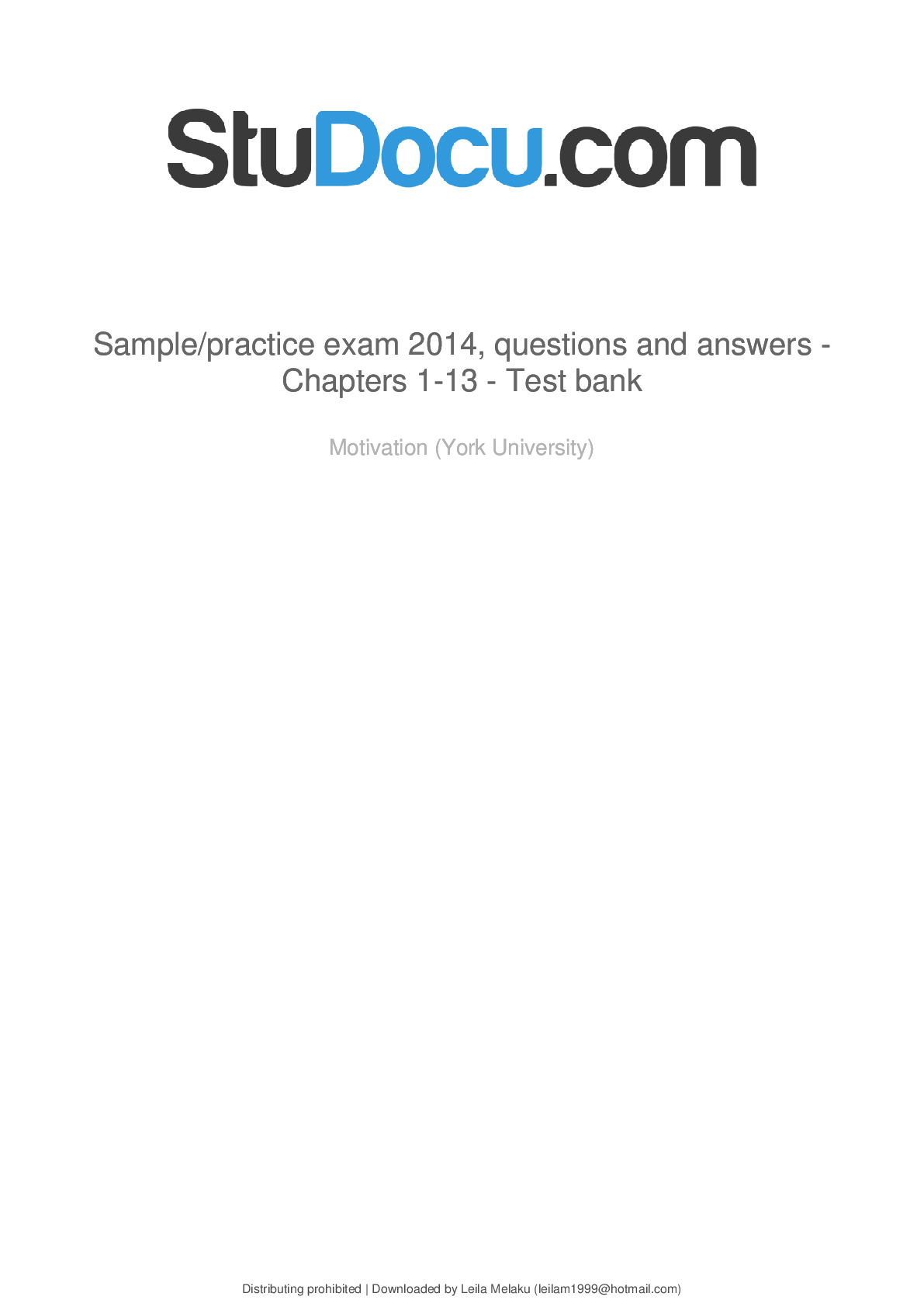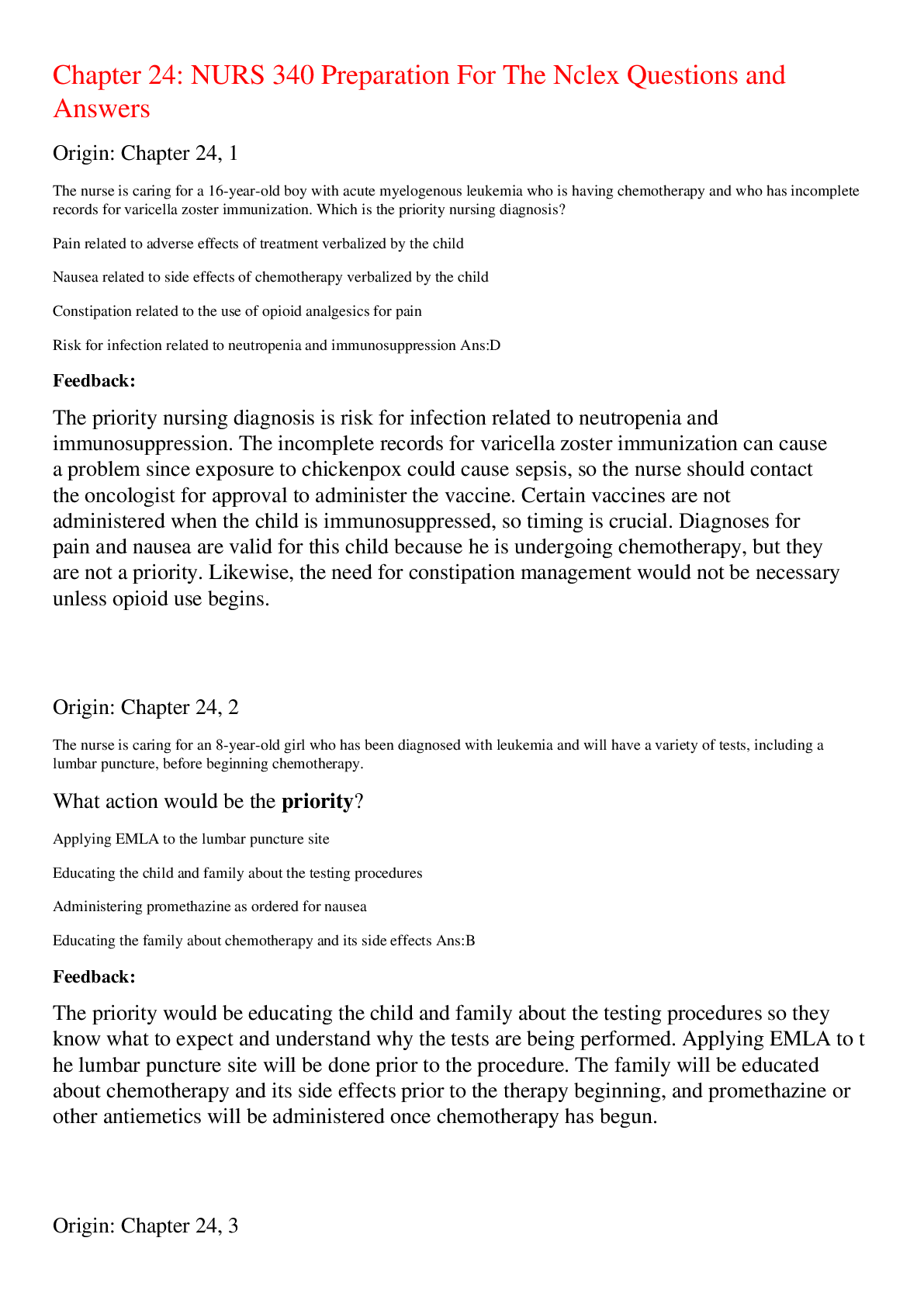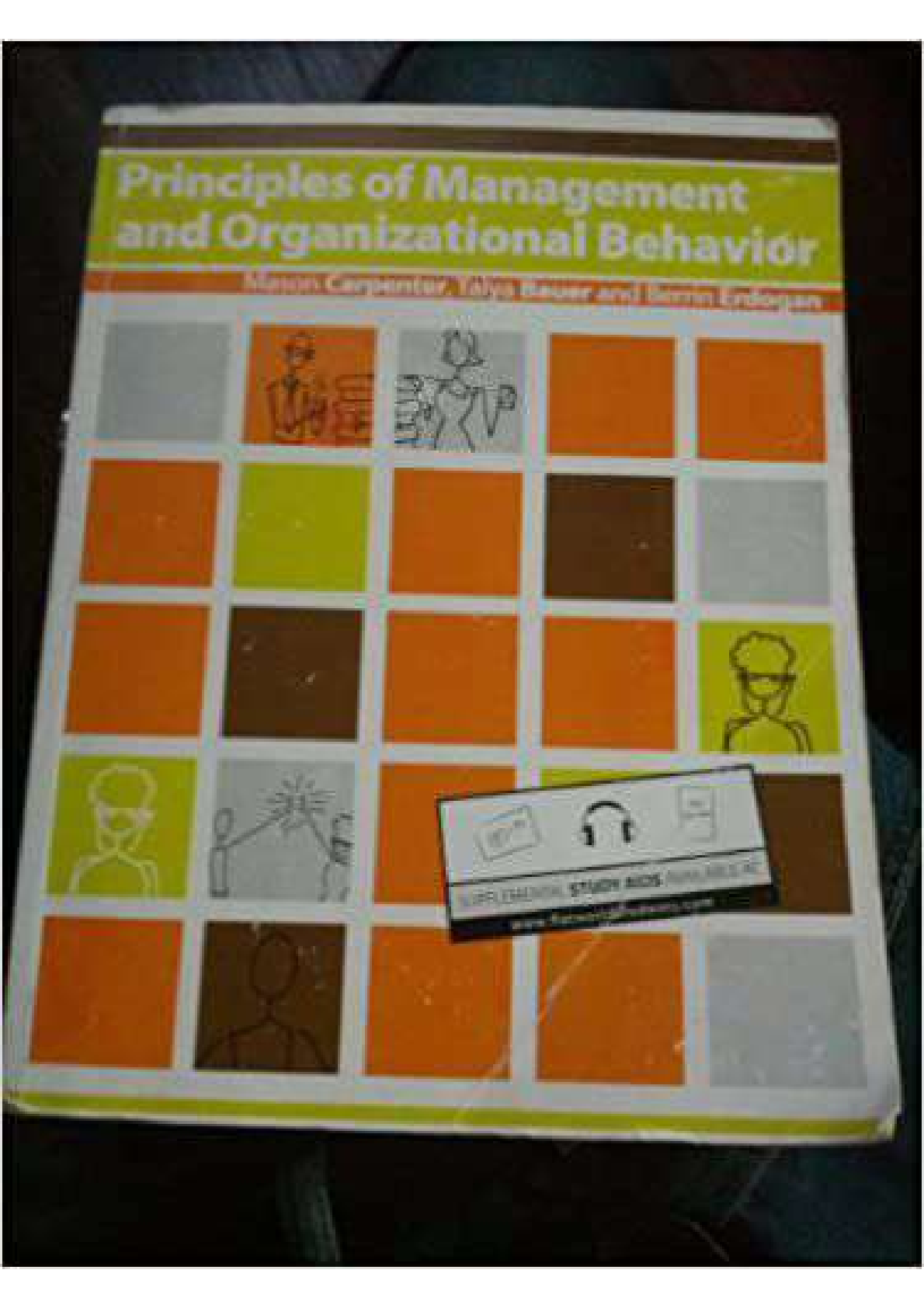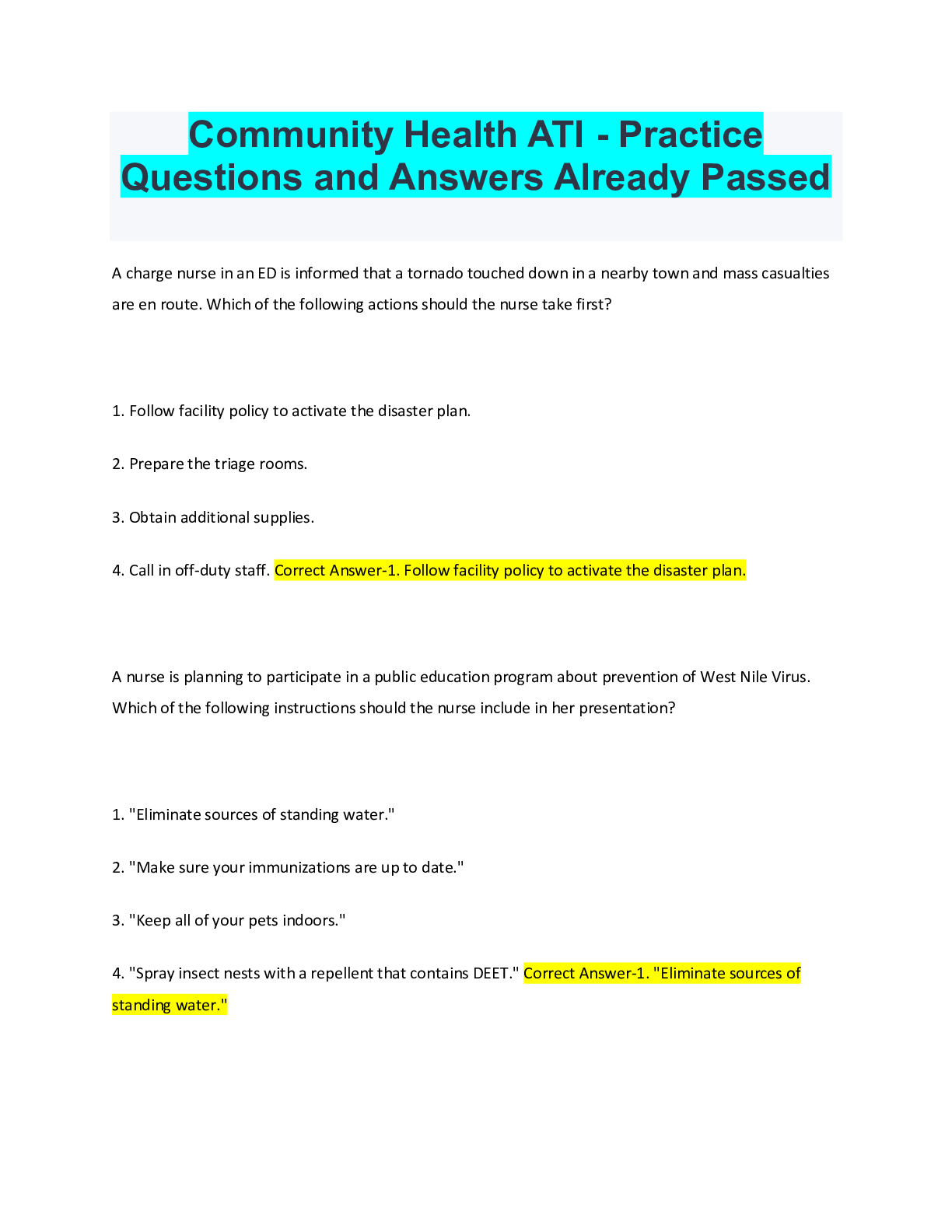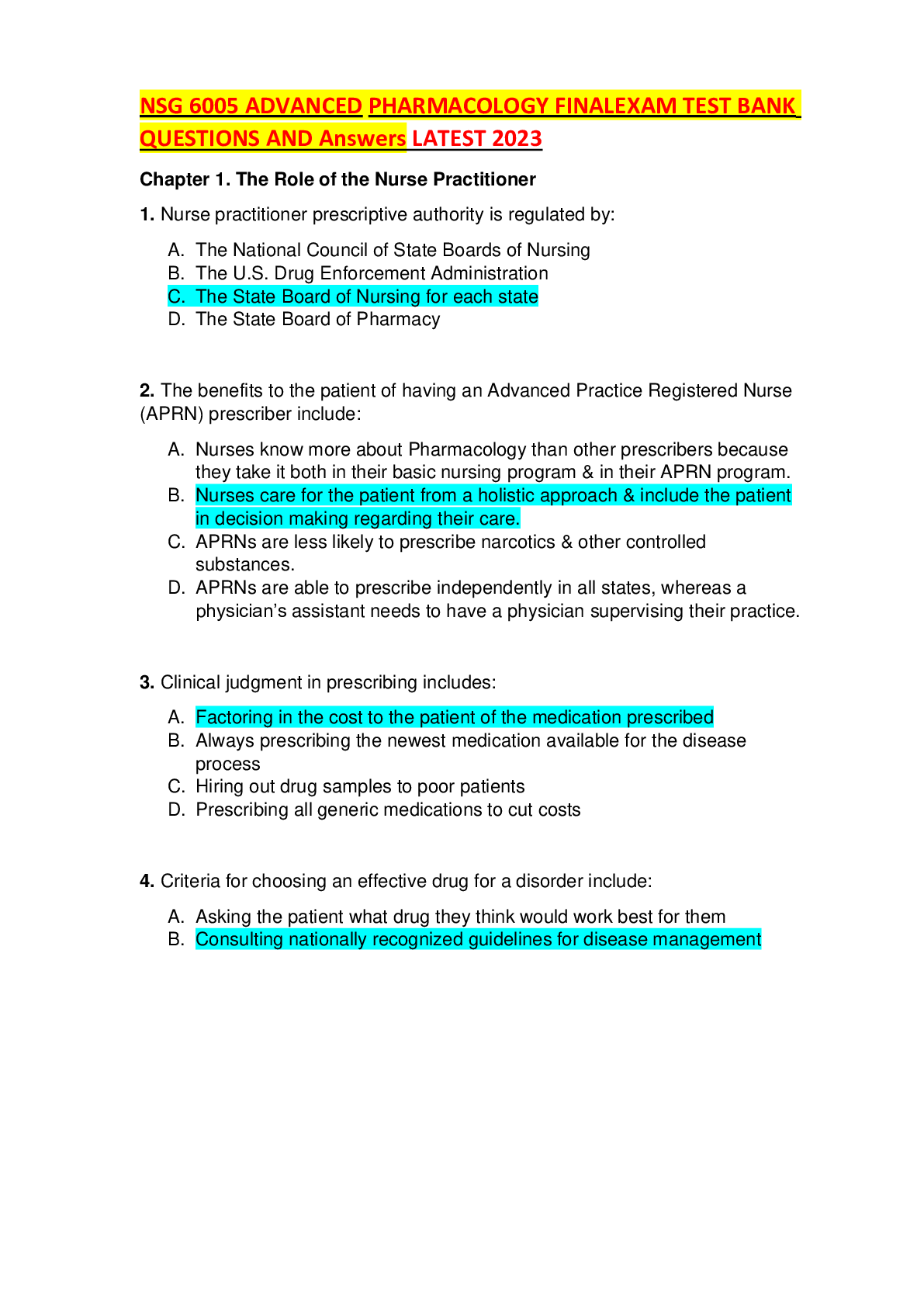*NURSING > TEST BANK > Test Bank:NSG 210 Concepts and Trends in Healthcare Questions and Answers and Rationale ,100% CORREC (All)
Test Bank:NSG 210 Concepts and Trends in Healthcare Questions and Answers and Rationale ,100% CORRECT
Document Content and Description Below
Test Bank:NSG 210 Concepts and Trends in Healthcare Questions and Answers and Rationale 1. Managed care organizations are insurers that carefully plan and closely supervise the distribution of healt... hcare services. What is one of the goals of managed care? A) Preventing illness through screening and promotion of health activities B) Improving training of healthcare professionals C) Eliminating health disparities between segments of the population D) Providing hospice or home hospice care Ans: A Feedback: Preventing illness through screening and promotion of health activities is one of the goals of managed care. Improved training of healthcare professionals is the priority for international health and not the goal of managed care. Eliminating health disparities between the segments of population is a goal of Healthy People 2020. Providing hospice or home hospice care is only for terminally ill clients. 2. In an effort to cut costs, hospitals have instituted many changes. Which of these cost- cutting factors is most likely to jeopardize the quality of care? A) Using unlicensed assistive personnel B) Increasing numbers of clients in hospitals C) Not devoting enough time to the client D) The rise of medical care costs in healthcare systems Ans: A Feedback: Hospitals are using unlicensed assistive personnel to perform some duties practical and registered nurses once provided. Many are concerned that the use of unlicensed assistive personnel will jeopardize the quality of care. Increasing numbers of clients in hospitals, not devoting enough time to the client, or the rise of medical costs are less likely to jeopardize the quality of care. 3. Since losing his right leg years ago, Mr. Smith and his wife have formed a community walking group to raise money for the homeless in his area. Which of the following has contributed to him being viewed as “healthy”? A) The client is married and is moving on. B) The client is experiencing high quality of life within the limits of the physical condition. C) The client is facing various states of health and illness. D) The client is physiologically and psychologically stable. Ans: B Feedback: Clients adapt physically, emotionally, and socially, enabling them to maintain comfort, stability, and self-expression. Clients with chronic illness can achieve a high level of wellness and experience high quality of life. Marriage is an aspect of quality of life but does not define the quality of the client's life. All clients experience various states of health and illness. 4.A 17-year-old client is having protected sex one to two times a week in a monogamous relationship. What is the client participating in? A) Health promotion B) Health maintenance C) Illness prevention D) Wellness Ans: B Feedback: Protecting one's current level of health by practicing safe sex to prevent illness is an example of a health maintenance activity. Health promotion strategies are used to enhance health, such as eating a diet high in fiber. Illness prevention includes identifying risk factors such as hypertension. Wellness is the balance of total well-being. 5.A client complaining of bloody urine has scheduled an appointment with a family practitioner. What type of care is the client receiving? A) Tertiary B) Secondary C) Skilled nursing care D) Primary Ans: D Feedback: The first provider that clients contact about a health need provides primary care; this person is typically a family practitioner or nurse practitioner. Secondary care includes referrals to facilities for additional testing. Tertiary care focuses on more complex medical and surgical intervention. Skilled nursing care occurs in facilities or units that offer prolonged health maintenance or rehabilitative services. 6. The hospital is having a problem with healthcare-associated infections. A committee has been established to study the problem and make recommendations. The nurse working on the committee knows that this work addresses what? A) Inpatient quality indicators B) Prevention quality indicators C) National Patient Safety Goals D) Patient safety indicators Ans: C Feedback: The Joint Commission has established National Patient Safety Goals that are updated annually. These safety goals have changed how patients are identified and prevent adverse effects. Some of the 2012 goals include reducing the risk of healthcare-associated infections. Patient safety indicators reflect the quality of care in hospitals but focus on potentially avoidable complications. Prevention indicators identify hospital admissions that could be avoided through high-quality outpatient care. Inpatient indicators reflect quality of care inside the hospital. 7. After hip surgery, a client is admitted to the rehabilitation hospital. What type of care is the client receiving? A) Secondary B) Tertiary C) Rehabilitation D) Primary Ans: B Feedback: Hospitals where specialized technology is available provide tertiary care. Primary care is the initial contact that a client has, such as an appointment with a family practitioner. Secondary care includes referrals for additional testing. Rehabilitation is aimed at restoring a person to his or her fullest ability. 8. An older man has been sick for 3 weeks but will not seek medical help even though he is able to get to the doctor's office. The client does not know what his insurance will cover. The client has many medical bills from treatments not covered and does not want to be faced with more. Why is this client waiting to obtain medical treatment? A) Cost B) Language C) Accessibility D) Culture Ans: A Feedback: Many groups, such as ethnic minorities and older adults, are underserved; many do not seek early services because they cannot afford to pay for them. Accessibility is not an issue because the client is able to get to the office. No cultural or language barrier is mentioned. 9. The Healthy People 2020 initiative targets the improvement of health for all. In addition to eliminating health disparities, what are the broad goals of this plan? A) Increasing technological innovations B) Preventing treatable problems C) Applying a systematic approach to health improvement D) Increasing the quality and length of a healthy life Ans: D Feedback: Two broad goals of the Healthy People 2020 initiative are to increase quality and years of healthy life and eliminate health disparities. Healthy People 2020 initiatives will help with treatable problems but will not prevent problems. The initiative does not apply a systematic approach to health improvement or increase technological innovations. 10. What method for financing healthcare is based on the ability to keep clients healthy and out of the hospital through periodic screening, health education, and preventive services? A) Managed care B) Preferred provider organization C) Health maintenance organization D) Point-of-service organization Ans: C Feedback: Health maintenance organizations strive to keep their costs low and members out of the hospital through periodic screenings, health education, and preventive services. Managed care organizations are insurers who carefully plan and closely supervise the distribution of healthcare services. Preferred provider organizations are a community network of providers who are willing to discount their fees for service in exchange for a steady stream of referral customers. Point-of-service organizations involve a network of providers; clients select a primary care physician within the group who then serves as the gatekeeper for other healthcare services. 11. The LPN is leading a cardiac rehabilitation support group. How can the nurse best demonstrate meeting the clients need holistically? A) Lead an exercise, show a video about healthy lifestyle changes, and invite a spiritual leader to talk with the group. B) Have the clients share various healthy low-cholesterol recipes and participate in a cooking class. C) Have the clients discuss ways to relieve stress and practice stress reduction. D) Demonstrate low-impact aerobic exercise to the group and bring in a lecturer on Tai Chi. Ans: A Feedback: Nurses practice from the perspective of holism, which is viewing a person's health as a state balance between body, mind, and spirit. Option A addresses all aspects of holism in caring for clients. Options B, C, and D address only one aspect of this level of care. 12.A client is brought into the emergency department by the rescue squad after involvement in a motorcycle accident with a severe spinal cord injury. What type of illness does the LPN view this event? A) Terminal B) Acute C) Chronic D) Catastrophic Ans: D Feedback: Illness refers to a state of being sick and can be viewed as catastrophic or a sudden, traumatic illness, which has occurred with this client. The client has suffered a traumatic accident with serious injury and would be classified as catastrophic. This event is not chronic, terminal, or acute. 13.A client with chronic obstructive pulmonary disease visits a local long-term care facility once a week to lead a bingo game for the residents. How does the LPN determine that this client is achieving a high level of wellness? A) The client enjoys the activity that she provides to the clients. B) The client finds satisfaction in socialization with the residents. C) The client is achieving a high quality of life within the limits of her illness. D) The client needs to feel a part of a group setting. Ans: C Feedback: Clients with chronic illness can achieve a high level of wellness if they can experience a high quality of life within the limits of that illness. This client would be considered healthy because she is engaged in a personal and social activity weekly. Although the client may enjoy the activity, find satisfaction in socialization, or need to feel a part of a group, the larger scope of wellness is option C. 14. The LPN is providing a program at the local YMCA about stress-reduction techniques combined with a 1-mile walk around the indoor track once a week. What does this type of program address for the community? A) Health promotion B) Health maintenance C) Illness prevention D) Early detection of illness Ans: A Feedback: Health promotion refers to engaging in strategies to enhance health such as eating a diet high in grains and complex carbohydrates, exercising regularly, balancing work with leisure activities, and practicing stress-reduction techniques. Illness prevention involves identifying risk factors such as a family history of hypertension or diabetes and reducing the effects of risk factors on one's health. Early detection uses screening diagnostic tests and procedures to identify a disease process earlier, so that treatment may be initiated earlier and be more effective. Health maintenance refers to protecting one's current level of health by preventing illness or deterioration, such as by complying with medication regimens, being screened for diseases such as breast and colon cancers, or practicing safe sex. 15. The LPN is collecting data at the clinic from a new client who is being seen for an employee physical. The client informs the nurse that both parents have a history of high blood pressure and his father had a stroke at age 52 years. The nurse discusses diet and exercise programs that may benefit the client. What is the nurse displaying with this information? A) Early detection B) Health maintenance C) Health promotion D) Illness prevention Ans: D Feedback: Illness prevention involves identifying risk factors such as family history of hypertension or diabetes and reducing the effects of risk factors on one's health. Early detection uses screening diagnostic tests and procedures to identify a disease process earlier, so that treatment may be initiated earlier and be more effective. Health maintenance refers to protecting one's current level of health by preventing illness or deterioration, such as by complying with medication regimens, being screened for diseases such as breast and colon cancers, or practicing safe sex. Health promotion refers to engaging in strategies to enhance health such as eating a diet high in grains and complex carbohydrates, exercising regularly, balancing work with leisure activities, and practicing stress-reduction techniques. 16. The LPN informs the secretary that a client is expected to come in for lab work. The secretary inquires about why the nurse refers to the individual as a client. What is the best response by the nurse? A) “We should refer to everyone as a client. They pay for our service.” B) “That's how the physician wants us to refer to them.” C) “Using the term client implies that they are an active partner in nursing care.” D) “Using the term client is more respectful that using the term patient.” Ans: C Feedback: A client is an active partner in nursing care, and the person receiving healthcare services should no longer play a passive, ill role. The use of the term client reflects the attitude of personal responsibility for health. Options A, B, and D do not address the reason for the term used. 17. The LPN is making a referral to physical therapy for a client who has had a hip replacement and is going to be discharged in 2 days. The nurse understands that having physical therapy included in the care of the client includes them in what discipline? A) Part of the healthcare team B) A discipline unto themselves C) Part of the administrative team D) The same discipline as the prescribing physician only Ans: A Feedback: The healthcare team consists of specially trained personnel who work together to help clients meet their healthcare needs. The team includes physicians, nurses, psychologists, pharmacists, dietitians, social workers, respiratory and physical therapists, occupational therapists, nursing assistants, technicians, and insurance company staff. Because physical therapists are part of the healthcare team, options B, C, and D would be incorrect. 18. The client is referred from the physician to a cardiologist for a cardiac catheterization to determine if the client has coronary artery disease. What type of care does the nurse understand that this is? A) Primary care B) Secondary care C) Tertiary care D) Acute care Ans: B Feedback: Secondary care includes referrals to facilities for additional testing such as cardiac catheterization, consultation, and diagnosis as well as emergency and acute care interventions. This client falls into this category due to the referral to the cardiologist for the cardiac catheterization. The client does not fall into the acute care category. Primary care would include being seen by the client's primary physician. Tertiary care focuses more on complex medical and surgical interventions, cancer care, rehabilitative services, long-term care such as burn care, and palliative and hospice care. 19.A client with terminal cancer is being referred to hospice services to assist with care of the client and the family in the home environment. What type of care does the nurse determine this is? A) Primary care B) Secondary care C) Tertiary care D) Acute care Ans: C Feedback: Tertiary care focuses more on complex medical and surgical interventions, cancer care, rehabilitative services, long-term care such as burn care, and palliative and hospice care. This patient is terminally ill and being referred for hospice service. Secondary care includes referrals to facilities for additional testing such as cardiac catheterization, consultation, and diagnosis as well as emergency and acute care interventions. The client does not fall into the acute care category. Primary care would include being seen by the client's primary physician. 20.A client comes to the clinic with the complaint that he has been ill for several weeks but do not have insurance and have delayed care. What does the LPN understand about the overall healthcare reform goals that will address issues such as this client? A) The goal of healthcare reform is to provide care to women, infants, and children. B) The goal of healthcare reform is to provide more healthcare programs to address illness. C) The goal of healthcare reform is to provide quality healthcare for those that can afford it. D) The goal of healthcare reform is to provide affordable healthcare to more citizens. Ans: D Feedback: The overall goal of healthcare reform is to provide affordable healthcare to more U.S. citizens. Other goals are to reduce the insurance companies' control of healthcare and to provide more assistance to senior citizens on fixed incomes. The other answers address other individual programs but not the broader terms of the healthcare initiative. 21.A 72-year-old client who is hospitalized will be going on anticoagulant therapy and will require home healthcare nurses to visit once weekly to draw blood for coagulation studies. What coverage does the client have that will cover this service? A) Medicaid B) Medicare Part A C) Medicare Part B D) Medicare Part C Ans: B Feedback: Medicare covers individuals who are 65 years of age or older, permanently disabled workers of any age with specific disabilities, and persons with end-stage renal disease. Medicare Part A covers hospital care, skilled care, hospice, and home health services. Medicare Part B covers medically necessary services such as physician services that are not covered under Part A. Medicare Part C is the Medicare Advantage Plan and includes Parts A and B. Medicaid coverage is coverage for indigent patients that are unable to afford healthcare and qualify financially. 22.A 65-year-old client is prescribed multiple medications for diabetes, hypertension, and angina and is going to the pharmacy to have the prescriptions filled. What coverage will the client use to assist with financial coverage of the medication? A) Medicare Part A B) Medicare Part B C) Medicare Part C D) Medicare Part D Ans: D Feedback: Medicare Part D is Medicare Prescription Drug Coverage and helps to cover and possibly reduce prescription drug costs and protect against catastrophic drug expenses. Medicare Part A covers hospital care, skilled care, hospice, and home health services. Medicare Part B covers medically necessary services such as physician services that are not covered under Part A. Medicare Part C is the Medicare Advantage Plan and includes Parts A and B. 23.A client informs the nurse that she is a single parent with four children and cannot afford to pay for medical insurance for her and her family. What coverage does the nurse understand this client and her family may be eligible for? A) Medicare B) Medigap insurance C) Prospective payment system D) Medicaid Ans: D Feedback: Medicaid is a federally funded, state-run program that provides medical assistance for individuals with limited incomes and resources. Qualifications vary from state to state, but, typically, clients qualify if they have children and a limited income. Medicare covers individuals who are 65 years of age or older, permanently disabled workers of any age with specific disabilities, and persons with end-stage renal disease. Prospective payment system is a method of reimbursement in which healthcare providers receive payment for services based on a predetermined, fixed rate. Medigap insurance policies are for people that have adequate resources to cover copayments and deductibles. 24.A client is a member of a group insurance plan in which he pays a preset, fixed fee for healthcare services. What type of insurance plan does the nurse understand the client to have? A) A preferred provider organization (PPO) B) A health maintenance organization (HMO) C) Medicare D) Medicaid Ans: B Feedback: An HMO is a group insurance plan in which participants pay a preset, fixed fee in exchange for healthcare services. The fee is not based on the number of services provided but rather is projected to the number of participants and expected services. A PPO operates on the principle that competition can control costs. Acting as agents for health insurance companies, PPOs create a community network of providers who are willing to discount their fees for service in exchange for a steady stream of referred customers. Medicare is for people that are age 65 years and older or disabled. Medicaid is coverage for those clients who are unable to afford healthcare. 25. An HMO client obtained a second opinion regarding a diagnosis of colon cancer. There was no authorization obtained for this second opinion from the client or primary care provider. What is the consequence of this action? A) The client will be responsible for the entire bill for the second opinion. B) The client will still receive full coverage. C) The client will be dropped from the HMO for breaking the rules. D) The client will be fined by the HMO for not using the authorization process. Ans: A Feedback: Members of an HMO must receive authorization for secondary care, such as second opinions from specialists or diagnostic testing. If members obtain unauthorized care, they are responsible for the entire bill. In this way, HMOs serve as gatekeepers for healthcare services. The member will not be fined or dropped from the program but will not receive coverage for the service rendered from the second opinion. 26. What does the nurse understand is the focus of healthcare when a client receives services from a health maintenance organization (HMO)? A) Avoiding coverage for needed services B) Health promotion and maintenance C) To offer discounted services to all patients D) High-quality service and contain cost Ans: B Feedback: If the HMO does not require much high-cost care, providers make money; if members use many high-cost resources, providers lose money. This method of financing provides the strongest incentives for limiting use of expensive services and focusing healthcare on health maintenance and promotion. If services such as diagnostic testing are required, the HMO will cover this and not avoid payment. Services are not discounted for patient's that are nonmembers or members. The goals of a physician hospital organization (PHO) are to maintain high-quality service and contain costs while fostering group contracts, collaboration, and capitation. 27. The LPN has been asked to assist in gathering data regarding the incidence of falls in the hospital as part of a project that is geared toward identifying avoidable contributing factors and their effects. What type of quality indicators (QI) is this considered? A) Prevention QI B) Inpatient QI C) Patient safety QI D) Pediatric QI Ans: C Feedback: Patient safety QIs reflect quality of care within hospitals but focus on potentially avoidable complications and adverse effects. Prevention QIs identify hospital admissions that could be avoided through high-quality outpatient care. Inpatient QIs reflect quality of care inside hospitals, including inpatient mortality for medical conditions and surgical events. 28.A client undergoing a surgical procedure at the hospital died related to complications during the procedure. The LPN is required to collect data about the event so that a cause can be determined. What type of quality indicators would be used in this incident? A) Prevention QIs B) Inpatient QIs C) Patient safety QIs D) Pediatric QIs Ans: B Feedback: Inpatient QIs reflect quality of care inside hospitals, including inpatient mortality for medical conditions and surgical procedures. Prevention QIs identify hospital admissions that could be avoided through high-quality outpatient care. Patient safety QIs also reflect quality of care within hospitals but focus on potentially avoidable complications and adverse events. Pediatric QIs reflect quality of care inside hospitals and identify potentially avoidable hospitalization among children. 29. The LPN is working with a team of nurses in order to develop protocols for managing care of clients who are having peritoneal dialysis on their unit. What type of care mapping would the nurse use for the development of these standards? A) Nursing care plan B) Standing orders C) Recipe for care D) Clinical pathways Ans: D Feedback: Protocols (also known as guidelines or standards) for managing care have been developed. Multidisciplinary teams use clinical pathways or care mapping for specific diagnoses or procedures, which standardize important aspects of care such as diagnostic workups, nursing care, education, physical therapy, and discharge planning across the estimated length of stay. A nursing care plan is individualized to meet the needs of each client and is not standardized. There is no “recipe” for care that will meet the needs of clients. Standing orders reflect a physician's order that is standardized for patients with a specific diagnosis or procedure. 30. The LPN is assisting with the development of a program to administer flu shots to a group of senior citizens. What type of prevention does this program reflect? A) Primary prevention B) Secondary prevention C) Tertiary prevention D) Prevalence Ans: A Feedback: Primary prevention is prevention of the development of disease in a susceptible or potentially susceptible population and includes health promotion and immunization. Secondary prevention is the early diagnosis and treatment to shorten duration and severity of an illness, reduce contagion, and limit complications. Tertiary prevention is healthcare to limit the degree of disability or promote rehabilitation in chronic, irreversible diseases. Prevalence is the number of cases of a disease in a specific population during a specific period. 31. The LPN working in the clinic has had several incidence of positive chlamydia cultures return in women with pelvic pain. The nurse understands that early diagnosis and treatment are essential measures in which to reduce contagion and limit the complications related to this infection. What type of prevention will the nurse use when these infections are treated? A) Primary prevention B) Secondary prevention C) Tertiary prevention D) Prevalence Ans: B Feedback: Secondary prevention is the early diagnosis and treatment to shorten duration and severity of an illness, reduce contagion, and limit complications. Tertiary prevention is healthcare to limit the degree of disability or promote rehabilitation in chronic, irreversible diseases. Prevalence is the number of cases of a disease in a specific population during a specific period. Primary prevention is prevention of the development of disease in a susceptible or potentially susceptible population and includes health promotion and immunization. 32. The LPN is working for a physician who participates in an HMO and will be assisting with the billing. What type of information regarding capitation does the nurse need to understand? A) Fees are not based on the number of services provided but rather are projected to the number of participants and expected services. B) Fees are based on the number of services that the primary care provider bills for. C) The HMO makes money based on the degree of illness and number of diagnostic tests that are done. D) The fees that are charged are different even with the same diagnosis. Ans: A Feedback: With an HMO, the fee is not based on the number of services provided but rather is projected to the number of participants and expected services. This type of financial management is referred to as capitation, which refers to the actual head or person count. Option A is incorrect because HMO is based on the number of participants and expected services. The HMO makes money by keeping people healthy and out of the hospital. The fees are the same regardless of the actual service or frequency of care provided. 33. An LPN has applied for a position in the hospital emergency department and is told that the facility only hires RNs and unlicensed assistive personnel (UAPs) in the emergency department. What concern does the LPN have with the practice of hiring UAPs in place of LPNs? A) LPNs will be phased out of the healthcare field altogether when more UAPs are hired. B) UAPs are performing some of the duties that practical nurses typically provide and may jeopardize the quality of care. C) UAPs will replace nurses because they deliver a better quality of care. D) State boards of nursing will begin to credential UAPs. Ans: B Feedback: Changes in the healthcare industry have also affected employment for healthcare workers. Hospitals employ UAPs to perform some duties that practical and registered nurses once provided. Many are concerned that the use of UAPs will jeopardize the quality of care. There is no evidence to indicate that LPNs will be phased out of the healthcare system or will replace nurses. State boards of nursing cannot credential an unlicensed person that does not go through a formal education program. 34. What statement by the LPN shows an understanding of the ultimate goal of Healthy People 2020? A) “The ultimate goal is that they will find a cure for diabetes.” B) “The ultimate goal is that they provide an overall action plan to improve health and quality of life.” C) “The ultimate goal is that everyone be within a normal weight.” D) “The ultimate goal is that everyone will exercise once daily.” Ans: B Feedback: The Healthy People 2020 campaign provides an overall action plan to improve the health and quality of life for people living the United States. The U.S. Department of Health and Human Services identified the four overarching health goals: Attain high quality, longer lives free of preventable disease, disability, injury, and premature death. Achieve health equity, eliminate disparities, and improve the health of all groups. Create social and physical environments that promote good health for all. Promote quality of life, healthy development, and healthy behaviors across all life stages. Health People 2020 is not focused on an individual disease process, a “normal” weight, or exercise for the individual as the overall goal. 35. The LPN is aware of the various changes in the healthcare field. What important factor remains the same in this time of change? A) Nurses must provide safe, high-quality, cost-effective care to individuals, families, and communities. B) Nurses must inform clients that they will have to use facilities that are within their service area. C) Clients must become actively involved in the process of standardizing care. D) Nurses will have to work in unsafe conditions in order to provide care to clients. Ans: A Feedback: In the midst of these dramatic changes and challenges, nurses must continue to provide safe, high-quality, cost-effective care to individuals, families, and communities. It is also imperative that nurses distinguish and communicate to clients the various choices that the clients may make about their healthcare. Clients have a choice as to location of care providers and are not limited to local facilities. Clients are not involved in standardizing care; this is a healthcare provider function. Nurses will not have to work in unsafe conditions in order to provide care to clients. [Show More]
Last updated: 10 months ago
Preview 1 out of 27 pages
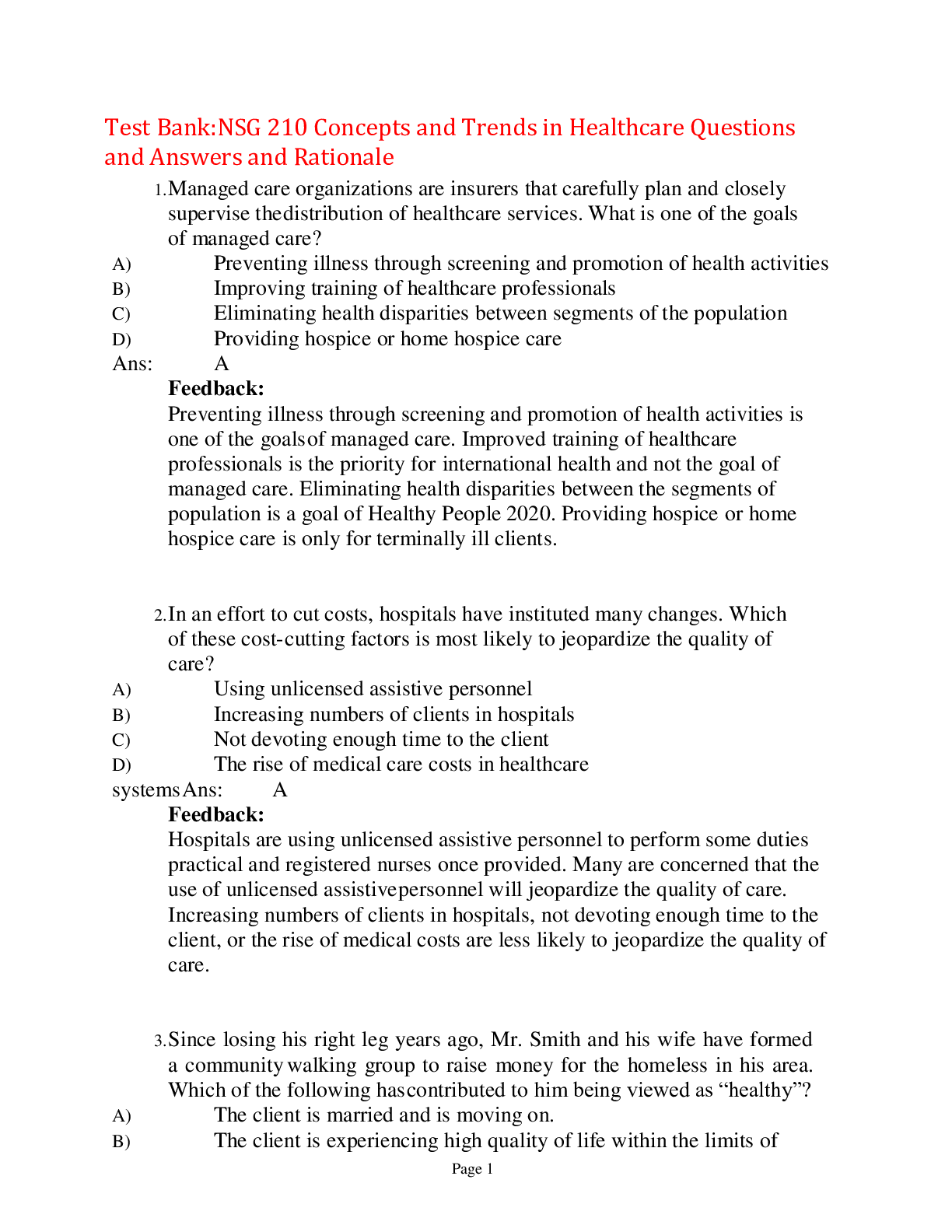
Reviews( 0 )
Document information
Connected school, study & course
About the document
Uploaded On
Sep 14, 2022
Number of pages
27
Written in
Additional information
This document has been written for:
Uploaded
Sep 14, 2022
Downloads
0
Views
31

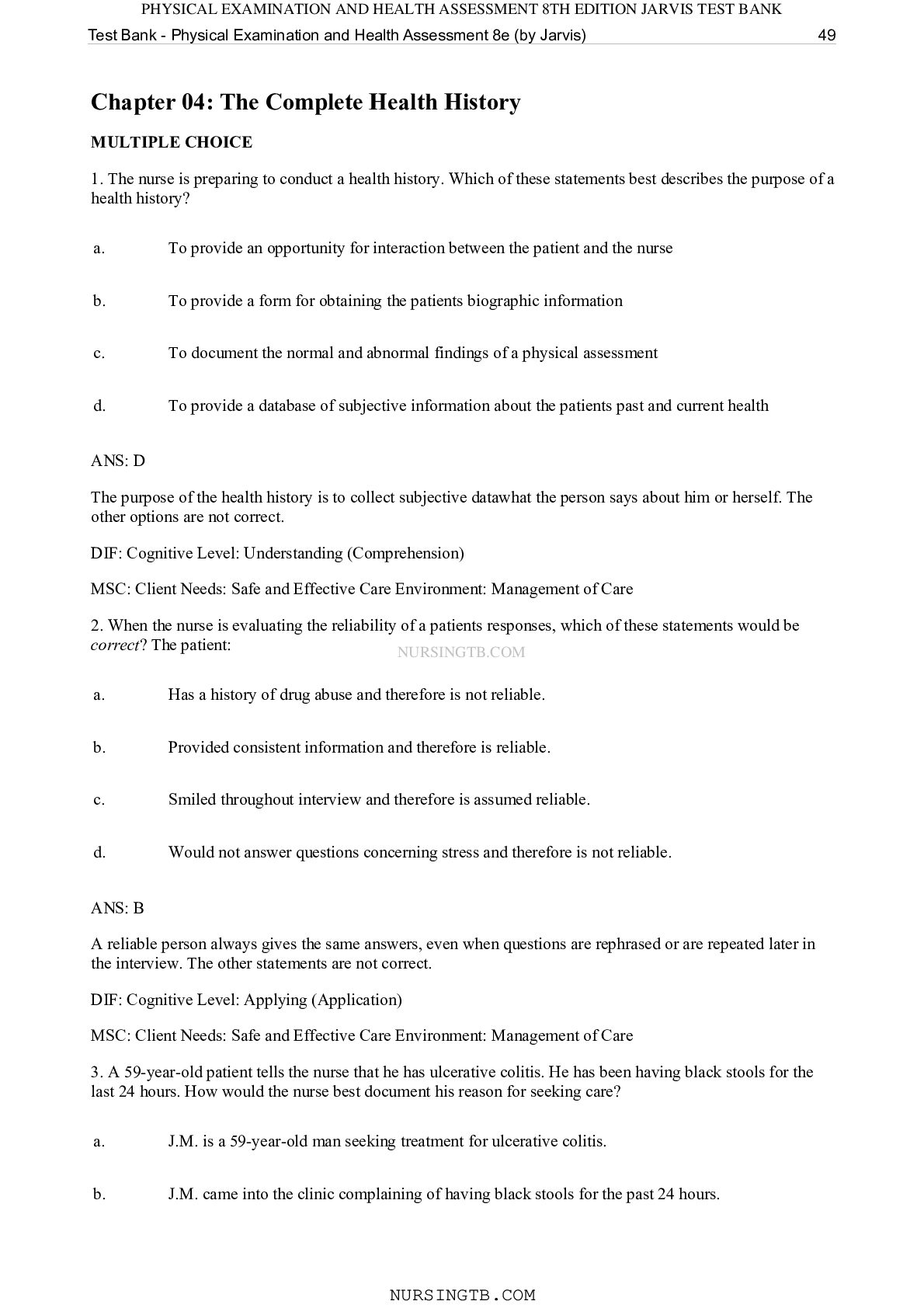









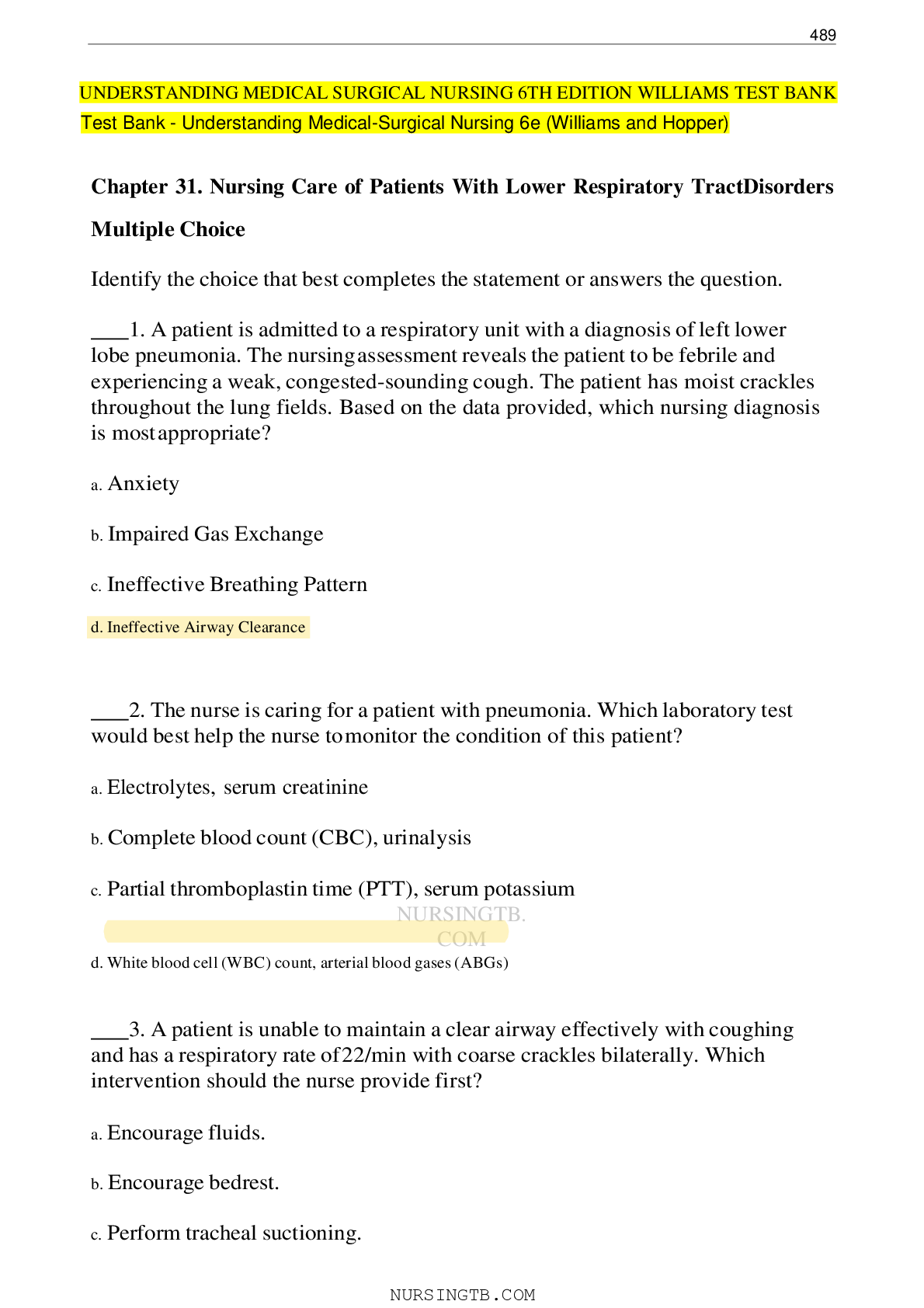

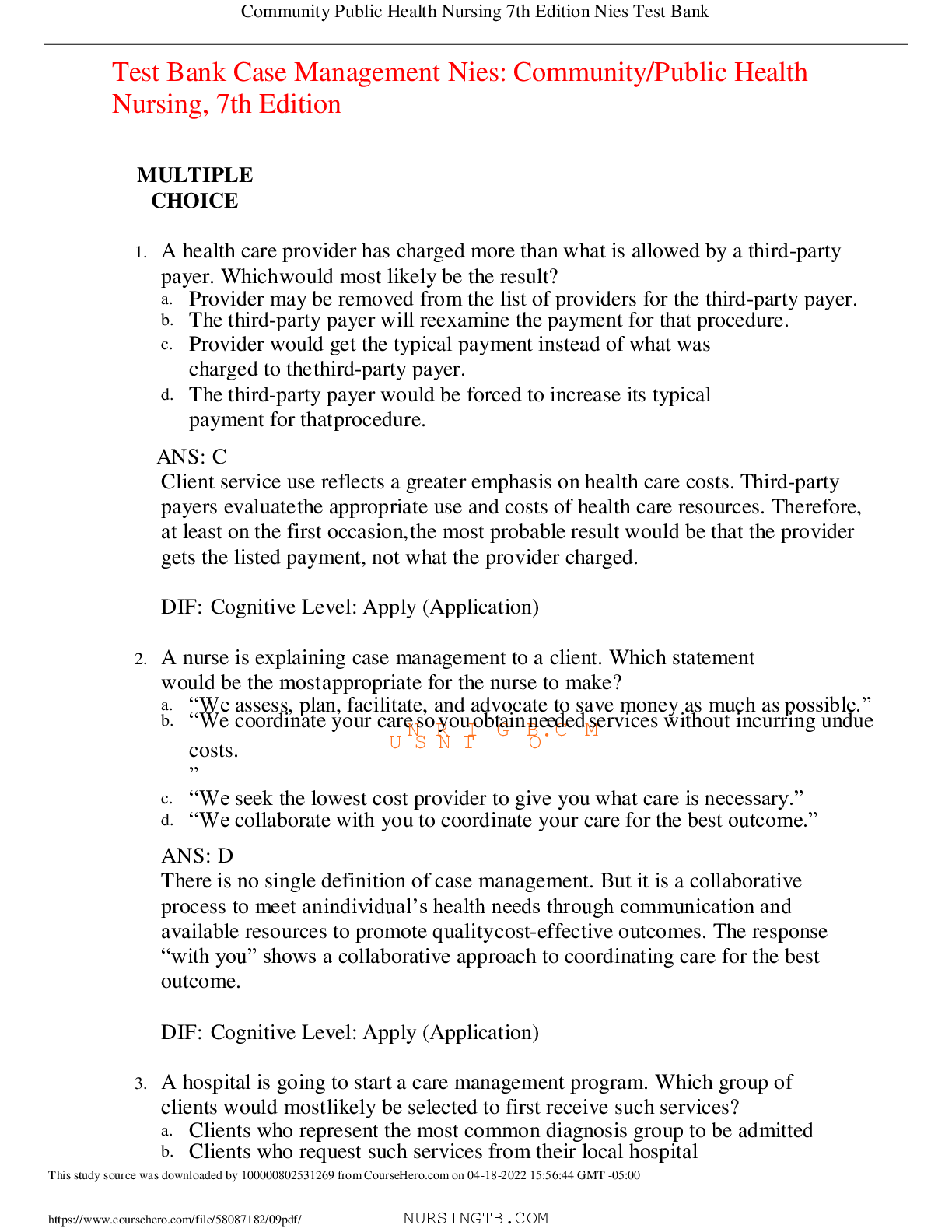

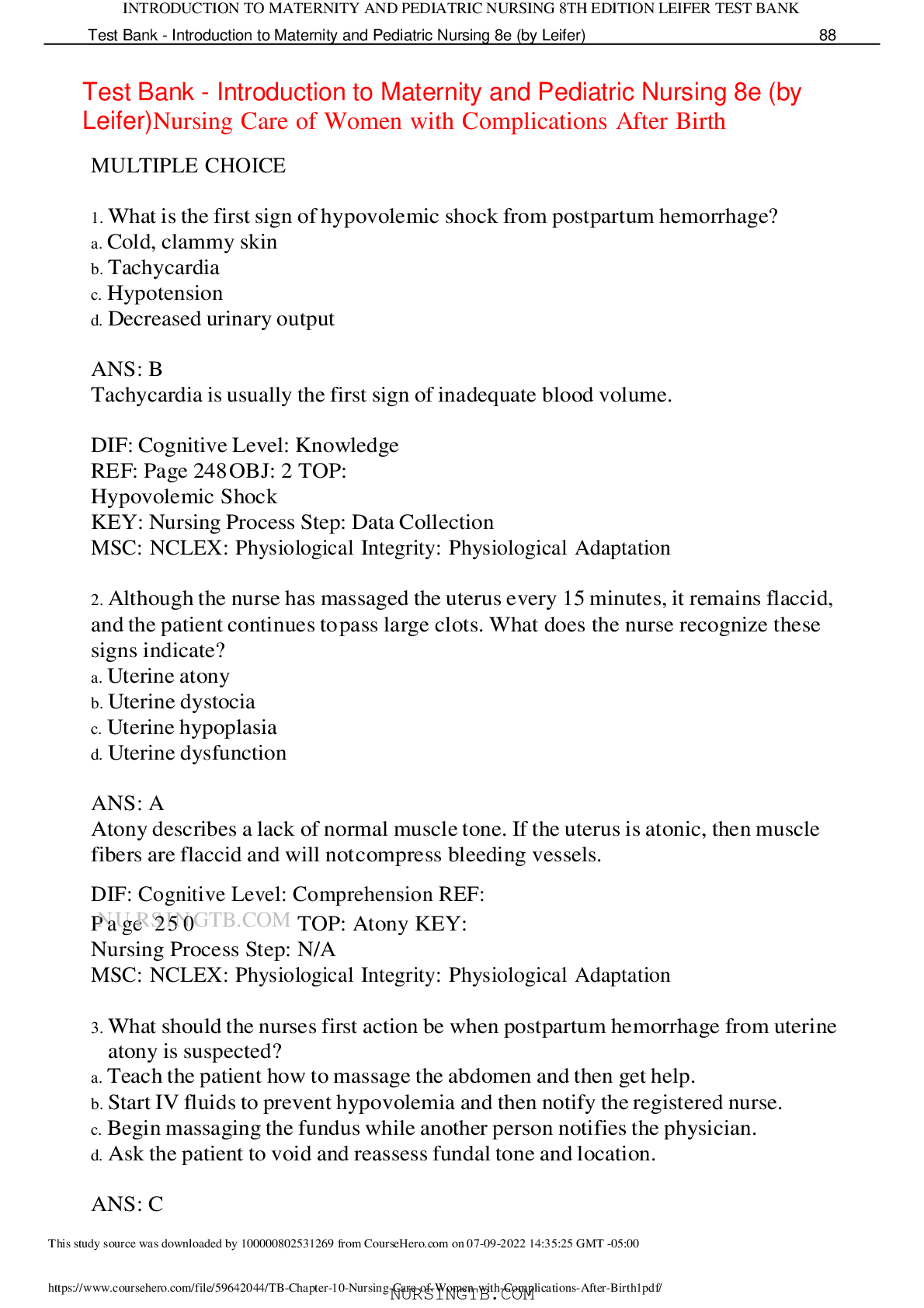

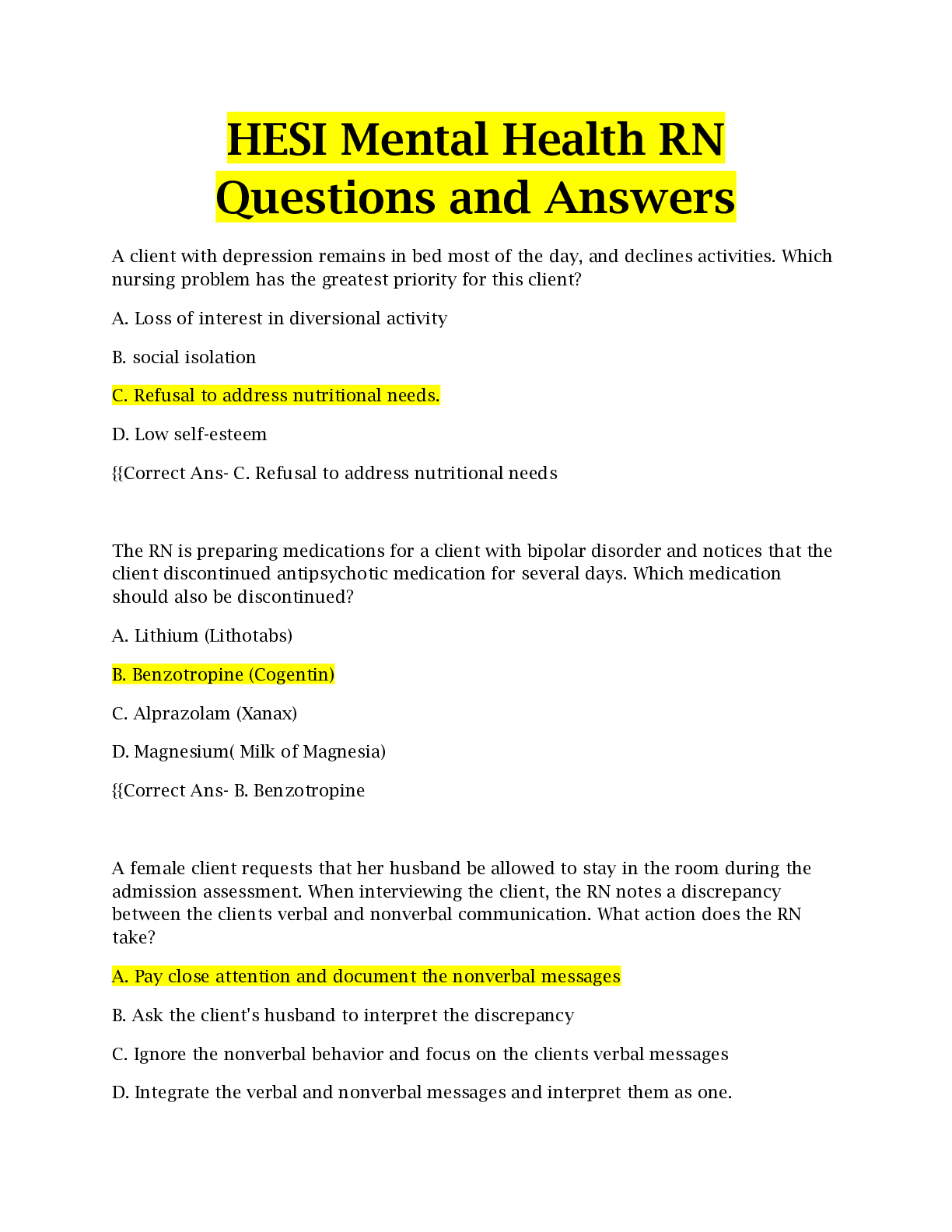
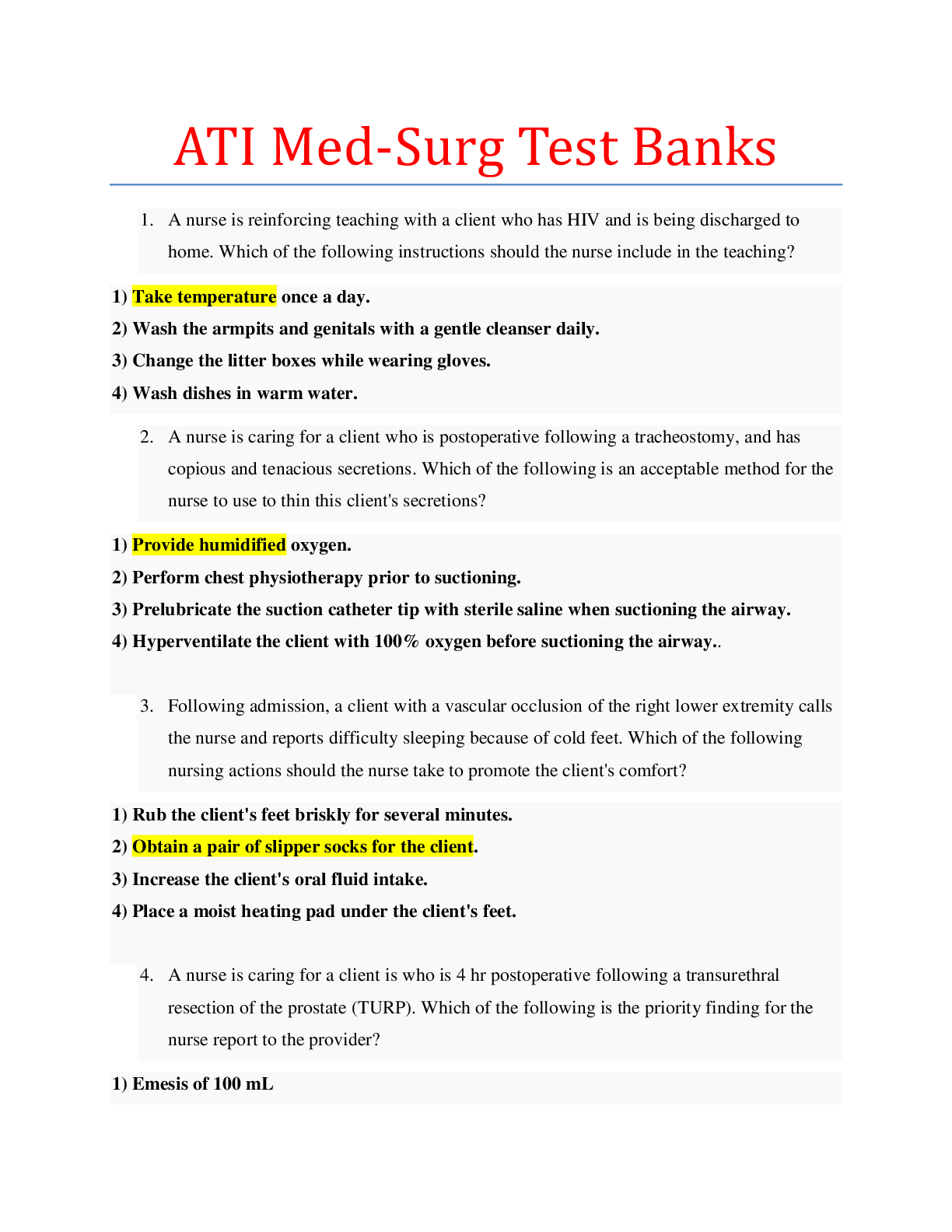
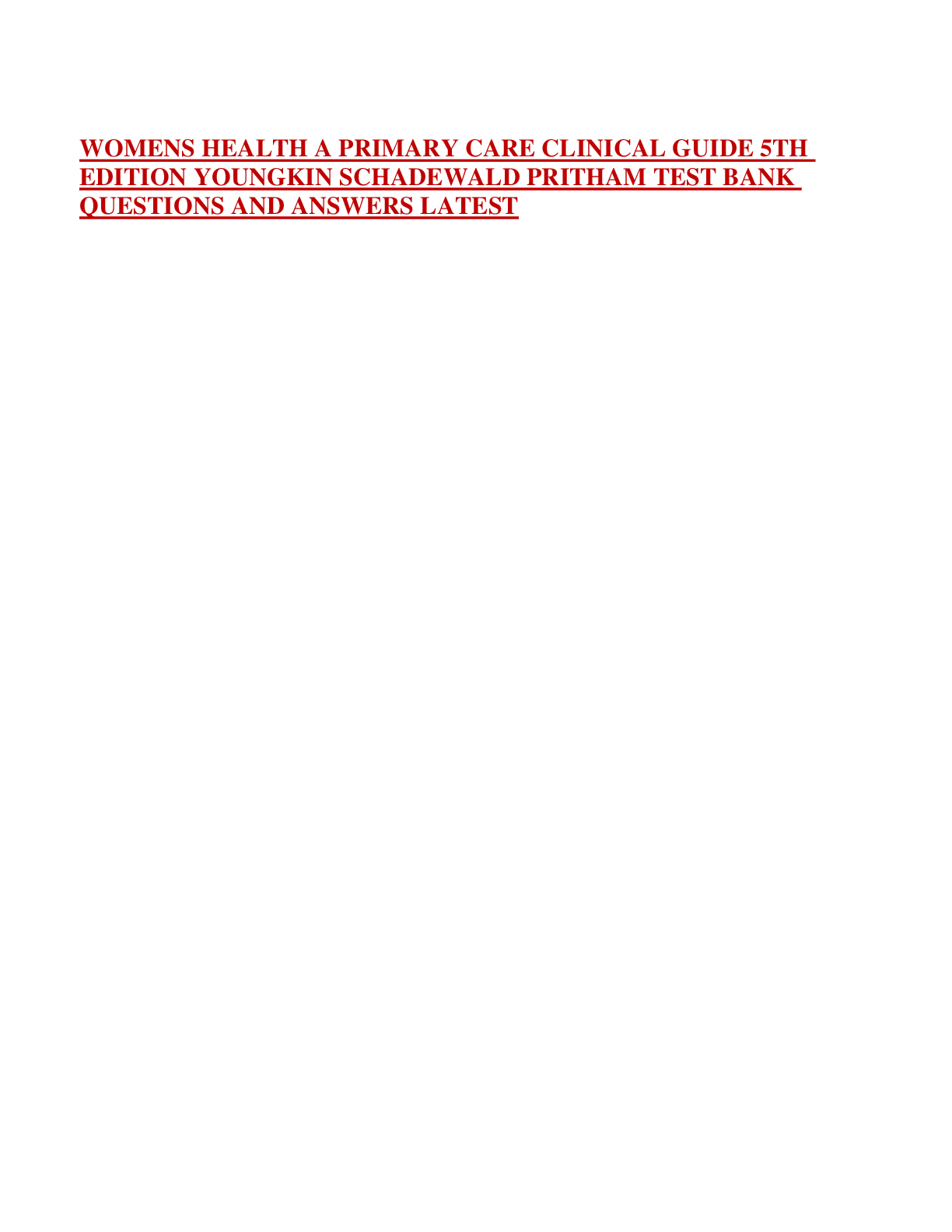
.png)
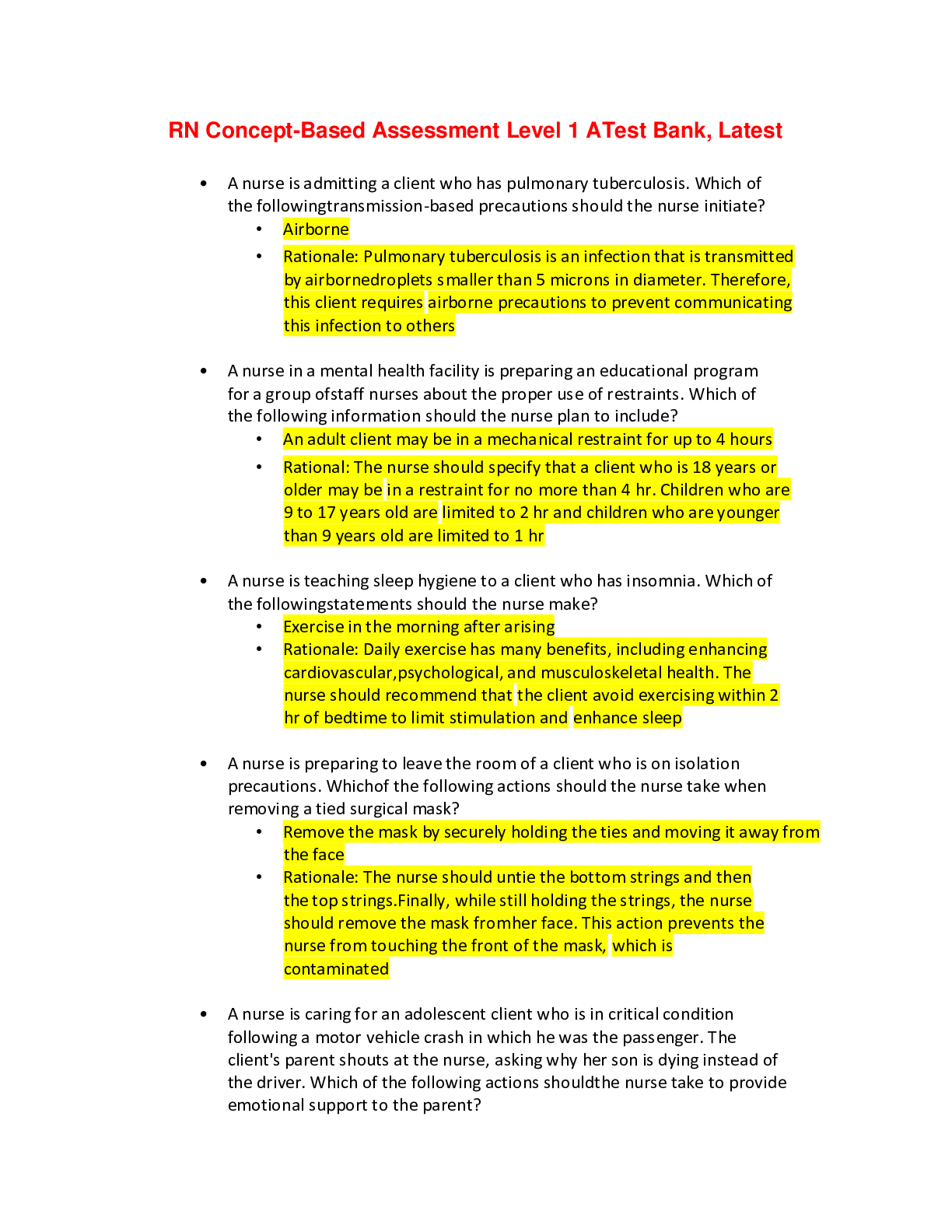
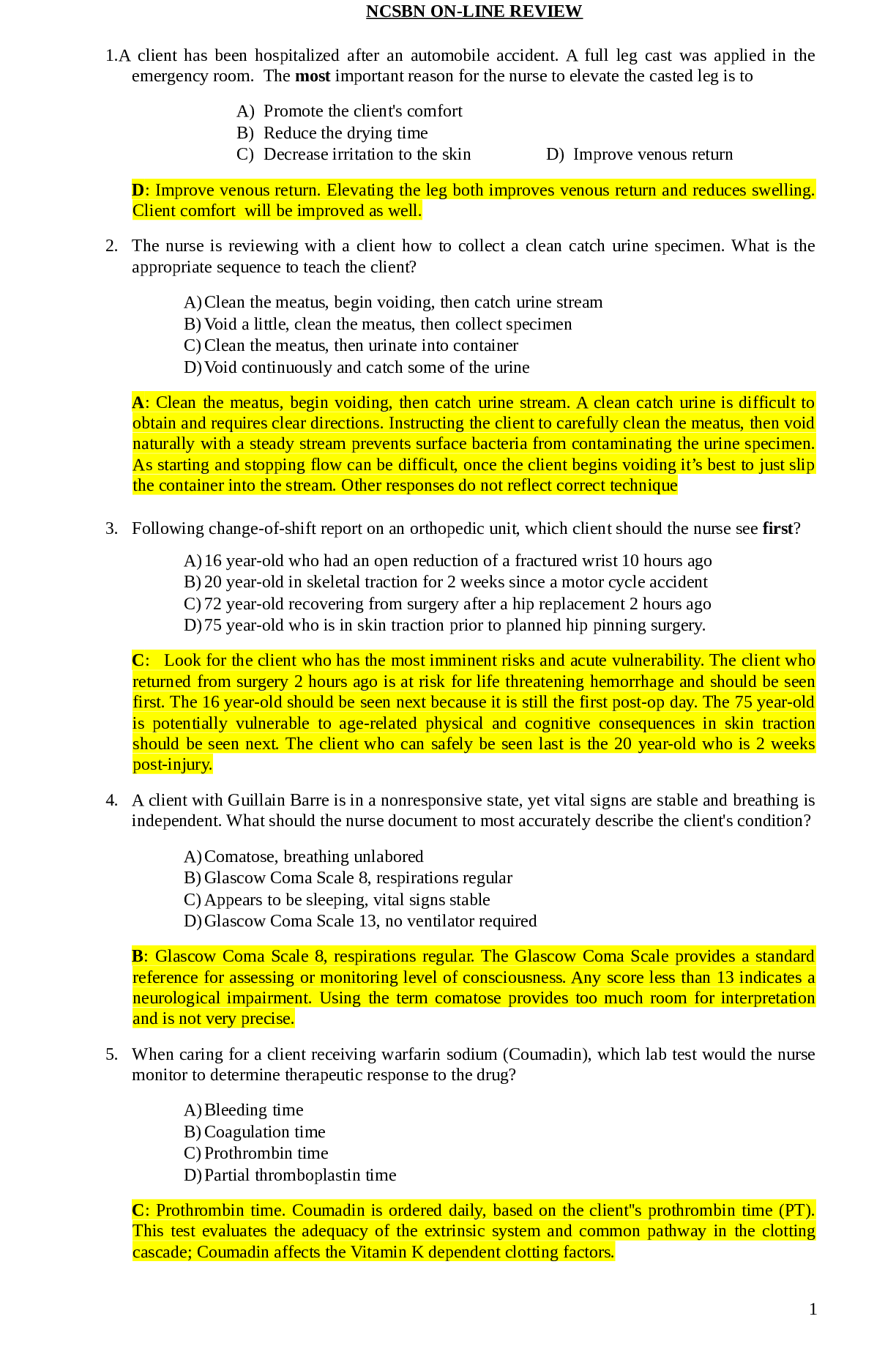

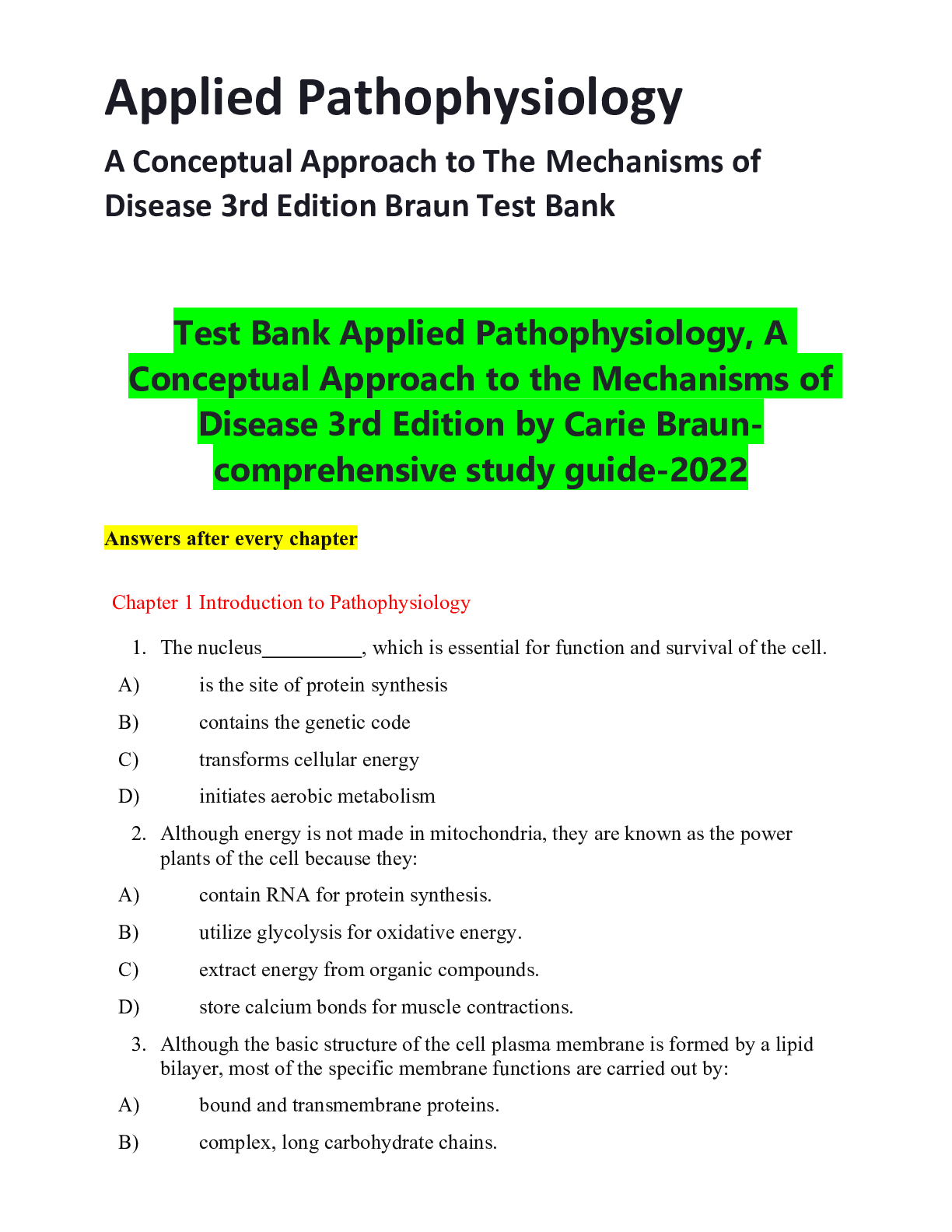
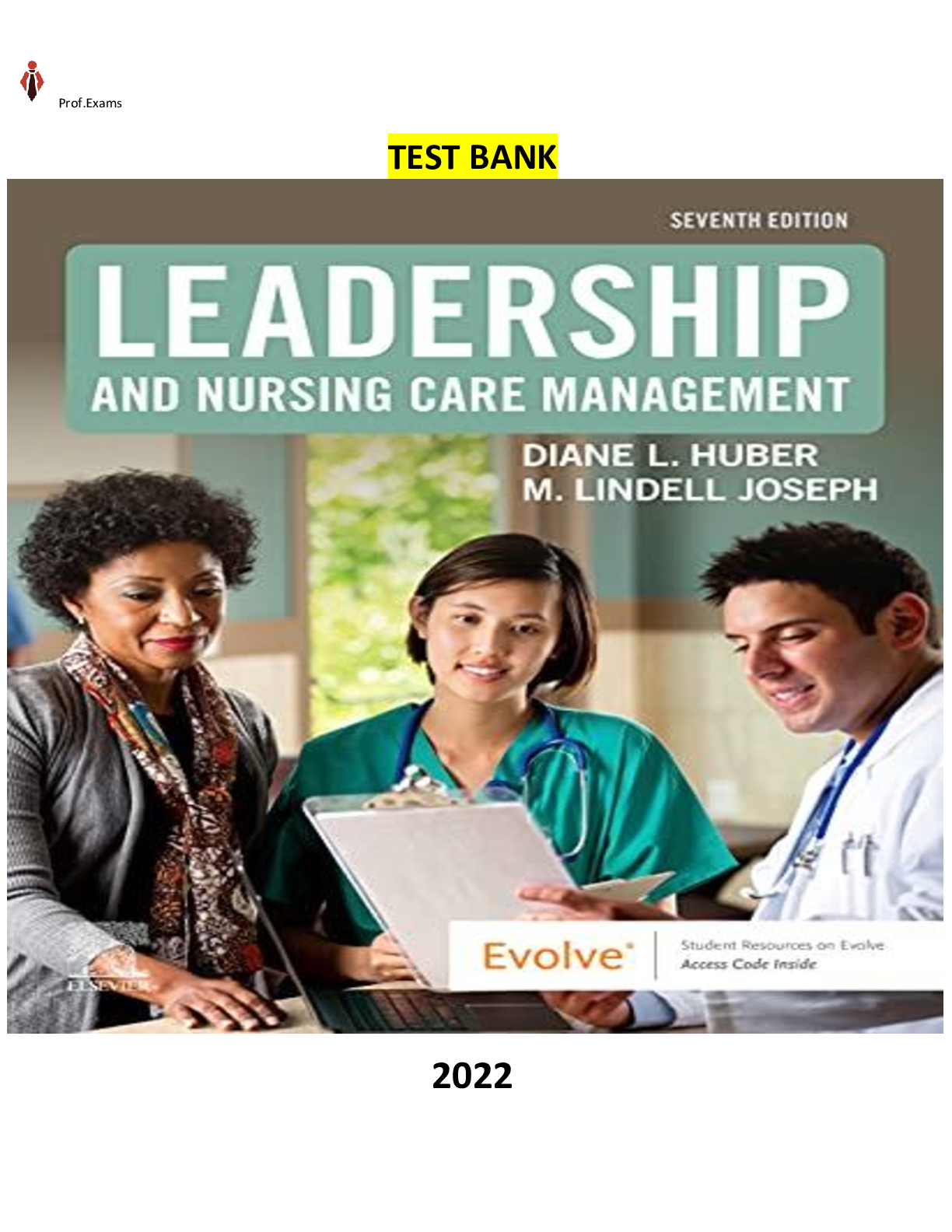
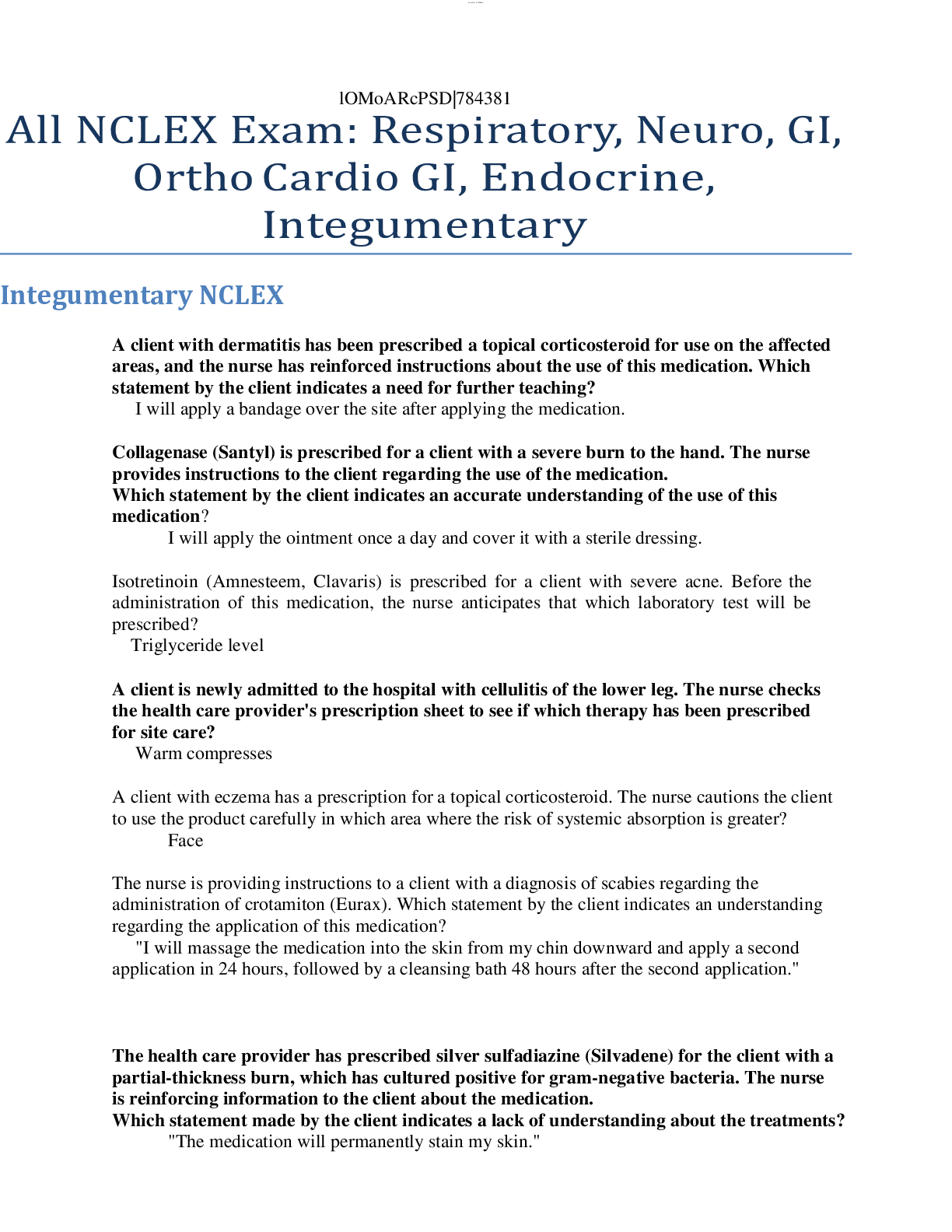
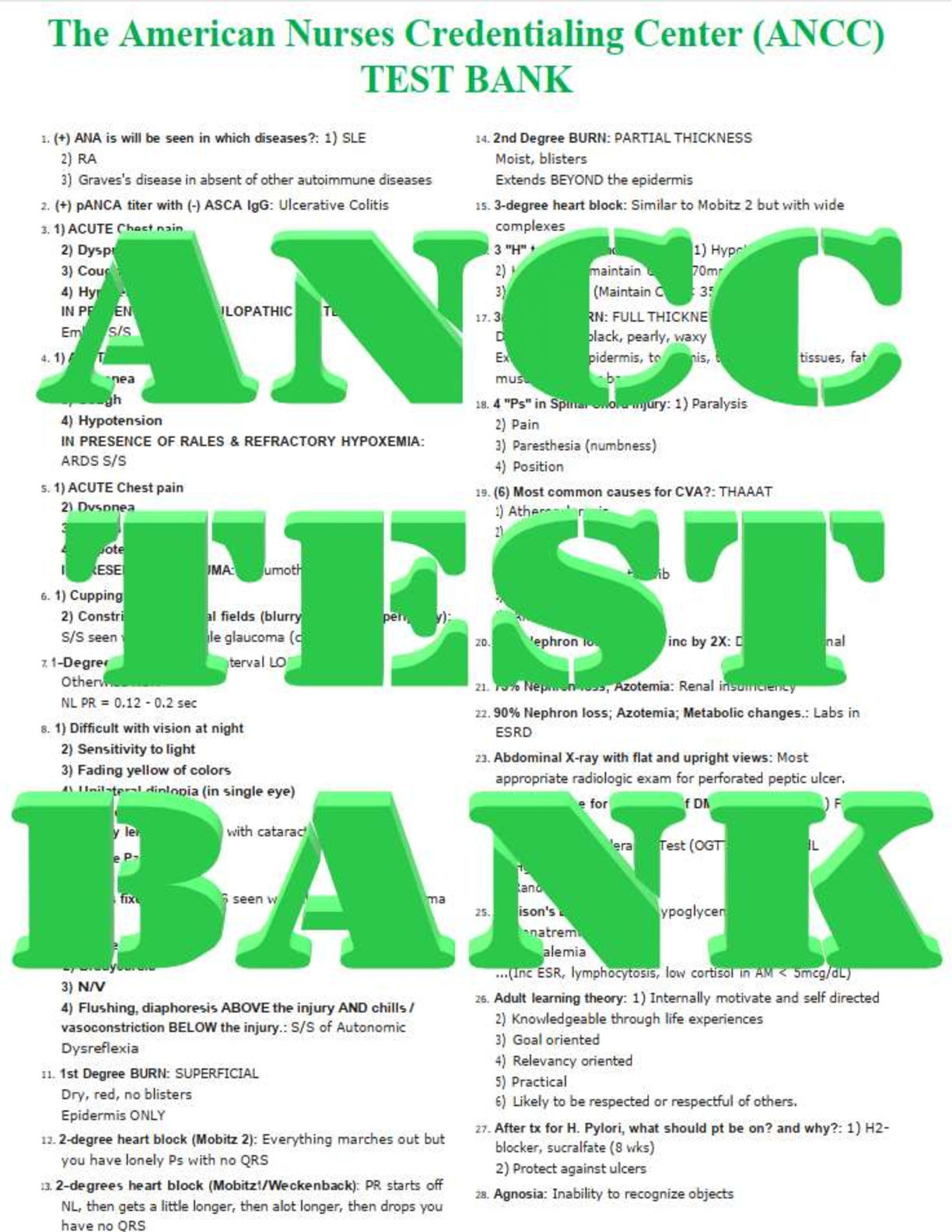
.png)
.png)
